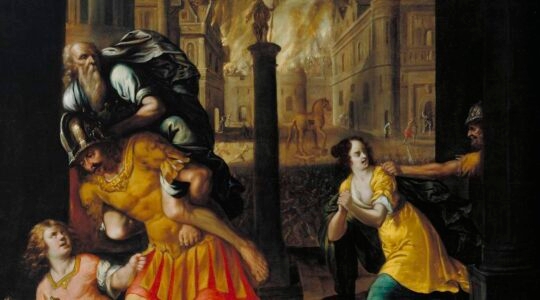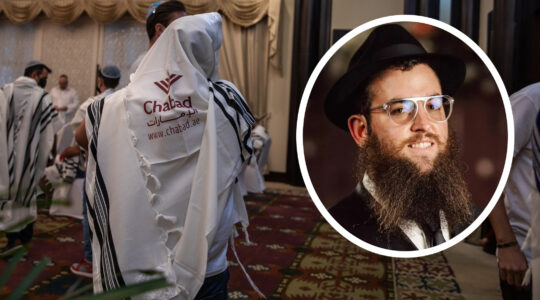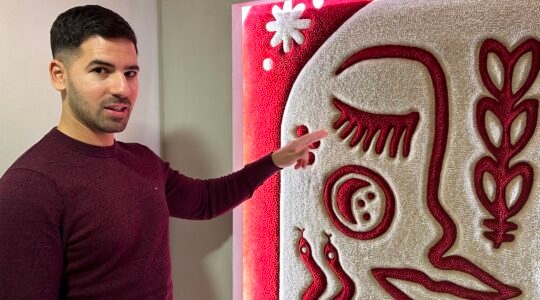BERLIN (JTA) — It’s a tradition that goes back hundreds of years in the Bavarian village of Oberammergau, nestled in the German Alps.
After witnessing it in the 1930s, Hitler reportedly proclaimed, “Never has the menace of Jewry been so convincingly portrayed as in this presentation of what happened in the time of the Romans.”
Today, however, the Oberammergau Passion Play — which depicts Jesus’ final days, involves nearly half of Oberammergau’s 5,000 residents in the production and is expected to draw roughly half a million visitors for its 102-performance run through October — looks a little different.
Director Christian Stuckl and deputy director Otto Huber have incorporated new elements to showcase Jesus’ Jewish observance, including one scene in which Jesus and his disciples lift the Torah at the Jerusalem Temple and recite the Shema.
For some Jewish critics, however, the play — which through the centuries of its performance has sparked deadly pogroms against Jewish communities in Europe — is still dangerously anti-Semitic. In the scene where Jesus is crucified, hundreds of Jews scream and clamor for his execution.
Rabbi Noam Marans, the American Jewish Committee’s associate director of interreligious and intergroup relations, called the scene “bone chilling.”
“Under the leadership of Oberammergau reformers Christian Stuckl and Otto Huber, the director and deputy director of the Passion play, the 1990, 2000 and 2010 editions are less offensive to Jews and concerned Christians than earlier versions,” Marans wrote in an Op-Ed distributed by the AJC. But, he noted, “In addition to worrisome stereotypes, the play regrettably still perpetuates the slanderous deicide charge that has historically sparked violence against Jews.”
“Most disturbing,” said the Anti-Defamation League’s director of interfaith affairs, Rabbi Eric Greenberg, is the “false accusation that ‘the Jews’ were responsible for the crucifixion.”
Nevertheless, the ADL and AJC were among the groups that noted that this year’s performance — the production is staged every 10 years — is not as anti-Semitic as in years past.
As if to underscore the point, during the intermission in one of the play’s first performances this year, the actor who depicts Jesus sat drinking beers with a group of American Jews. The Americans had come to Oberammergau to meet with the Christians in the performance to discuss the play — and the violent anti-Semitism it inspired throughout the ages.
They came as part of a seminar sponsored by the AJC and the Berlin-based Germany Close Up program. Marans initiated the program.
“There has clearly been tons of progress” in recent decades, said Elissa Sagor, 23, one of 15 American Jewish students and young professionals who spent 10 days this month in Germany.
“The old costumes on the Jewish high priests had horns,” said Sagor, who works for the AJC in New York. “Now they are attempting to Judaize Jesus.”
During the participants’ visit to Oberammergau — part of a trip that took them to Berlin to meet with theology students at Humboldt University, to a Christian ecumenical conference near Munich and to the memorial at the former Sachsenhausen concentration camp — they were hosted by local Christian families.
The Passion Play runs from May 15 to Oct. 3, and features more than 2,000 local residents playing all the roles. The covered auditorium in which the performance is held seats 4,700 and faces an open-air stage framed by soaring mountains. Virtually all the local men have let their beards and hair grow out for the performances.
“It’s like a Passion Play Disneyland,” Sagor said.
Elliot Leffler, 30, a graduate student in theater at the University of Minnesota, said he didn’t think the play shows that the Jews killed Jesus.
“I recognize, of course, that many of the bad guys in the narrative are Jews,” Leffler said. “But many of the bad guys are also gentiles, and many of the important Jews are likeable, admirable, empathetic characters. This is not only good for Jewish-Christian relations; I imagine it also has significant theological ramifications for how Christian audiences make sense of Jesus’ death.”
David Rees, director of the Munich Synagogue choir, Shma Koleinu, said he was impressed by how Stuckl “succeeds in placing the Passion story squarely in a Jewish context.”
He said Stuckl’s production “belongs to a world altogether different from the Passion Play’s anti-Semitic past.”
Stuckl consulted with Rees to get the Jewish prayers just right. Rees coached the actors and “suggested ways of holding and handling their stage-prop Torah scroll,” he said in an e-mail to JTA.
“Stuckl has created a very Jewish Jesus,” Marans acknowledged.
When Jesus holds up a facsimile of the Torah, 400 Oberammergau residents playing Jews sing the Shema.
“It is an incredible moment in the history of the Oberammergau Passion Play,” Marans said, “because one of the desiderata of the negotiations over the decades is that there should be complete clarity regarding the Jewishness of Jesus.”
It’s not easy to satisfy both Jewish and Christian viewers, Stuckl said. The scene in which spectators call for Jesus’ death is a core element that is hard to excise, he said.
“There are certain parts of the Gospel that are very hard to avoid,” Stuckl said. “But in every Passion Play we try to get closer” to Jesus’ Jewish roots and to remove aggression from the play.
JTA has documented Jewish history in real-time for over a century. Keep our journalism strong by joining us in supporting independent, award-winning reporting.





